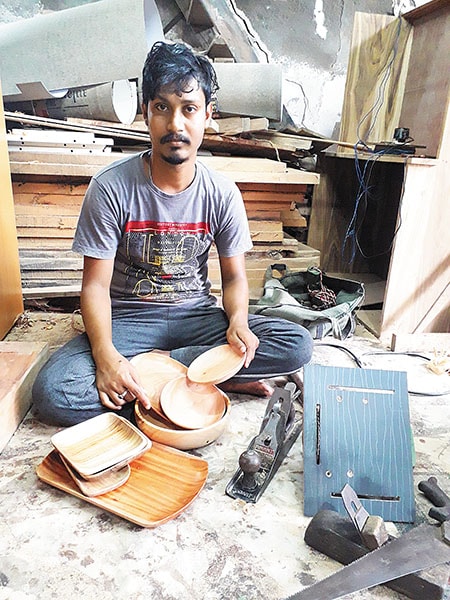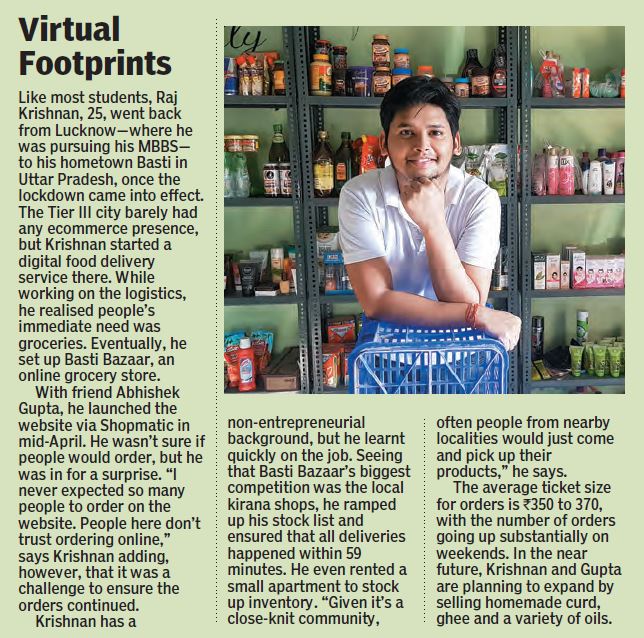
Unlocking the digital door
The pandemic and change in consumer buying patterns have prompted individual sellers as well as large and small businesses to take the ecommerce route for survival
 Ashish Das of Cacia Wooden Crafts, who used to sell his products at exhibitions, has been a seller on Amazon since the lockdown
Ashish Das of Cacia Wooden Crafts, who used to sell his products at exhibitions, has been a seller on Amazon since the lockdownAshish Das had a thriving business. The owner of Cacia Wooden Crafts in Kolkata, West Bengal, used to sell wooden home accessories and kitchenware at exhibitions. But then came the coronavirus outbreak and subsequent lockdowns since March-end which put him in a spot. “I had no money,” recalls Das. Luckily, however, three days before the lockdown was imposed, he had set up an account on ecommerce platform Amazon to earn some additional money. And, as he points out, “what was supposed to be ‘side income’ ended up becoming my only income.”
Das has a collection of over 100 products, and has listed 30 on Amazon for now. “Through them, I am earning about ₹30,000 to ₹35,000 a month. I plan to have close to 150 products on Amazon soon,” says Das, who concedes that the money isn’t close to what he earned from exhibitions. “But I have no complaints… if I wasn’t selling online, I don’t know how I would have survived.”
Das is just one of many sellers who never imagined ecommerce would be their focus, and means of survival, at any point. But the pandemic and resultant consumer behaviour have prompted them to take the digital route where minimal overheads are a blessing. Many small and large businesses, too, have finally taken the digital plunge and are strengthening their virtual presence.
 After she started selling on LBB in May, Shweta Arora of Silayi, an apparel brand, has found new markets open up for her clothes
After she started selling on LBB in May, Shweta Arora of Silayi, an apparel brand, has found new markets open up for her clothesThe entrepreneurial bug bit Shweta Arora, 30, when her collection—designed for a photographer friend’s fashion shoot—was well-received. Enthused by the feedback, she launched apparel label Silayi in 2018 to sell cotton handloom dresses. “I rented an office in Borivali because I didn’t have enough space to keep the stock,” she says. “And then the pandemic happened. I held on to the office till April, but the cost of overheads didn’t make sense after that. So I gave it up.” Prior to Covid-19, the Mumbai-based designer sold her collection only via exhibitions, but those events stood cancelled because of the pandemic.
In May, when delivery of non-essentials started, Arora saw a ray of hope in selling via ecommerce platforms. The month after, she joined LBB as a seller and now claims to be earning ₹1 lakh to ₹1.5 lakh per month through sales. The amount is less than what she got through exhibitions and events, but she hopes to add to her revenue with a complete focus on ecommerce in the near future.
 Kerala-based Elite Foods always sold its products via offline channels but now executive director Danesa Raghulal is set to launch the company’s own ecommerce platform
Kerala-based Elite Foods always sold its products via offline channels but now executive director Danesa Raghulal is set to launch the company’s own ecommerce platform
“The overheads are much higher for offline events. I’ll be finding more marketplaces like LBB and have even taken an import-export licence to take my brand to international markets,” says Arora, adding that her brand’s popularity has improved, with demand from South India too, and market size has grown tremendously as well. “Now, if one design doesn’t sell in a particular area, it ends up selling in some other area.”
Like Silayi, other players who moved online have seen their market open up not only in India but also globally. One such entity is Bengaluru-based SKD Leather, which currently sells masks on Amazon. Its owner and managing director Avhinandan Singhi first set up a watch business in Delhi and then moved to Bengaluru to expand it. Nineteen years later, he has diversified into three different ventures: Watch components, leather/metal watch bands and hardware furniture fittings. Until the coronavirus outbreak, Singhi had always kept putting off the company’s shift to online. “It was always on the back burner for me,” he says.
Things would have remained the same but for the lockdowns. SKD Leather’s core business is manufacturing leather and metal watch straps for other major manufacturers, including Timex and Maxima. The lockdown was announced just when the company was about to close a deal with Titan. “It was like you are about to hit the peak and suddenly you are thrown to the ground,” recalls Singhi.
SKD Leather’s team assumed things would return to normal in a few weeks. However, as business remained shut for two months, orders started getting cancelled. “We had zero orders and no revenue. We were only spending money on retaining key people and maintaining the industry,” says Singhi, “The only way to start recovering our losses was to move online.”
 (Left to right) Mukesh Maheswari, Kishore Jain, Hemant Bhardwaj, Meena Bhardwaj and Amarlal M of dry fruit brand Melting Hearts set up their ecommerce website via Shopmatic
(Left to right) Mukesh Maheswari, Kishore Jain, Hemant Bhardwaj, Meena Bhardwaj and Amarlal M of dry fruit brand Melting Hearts set up their ecommerce website via ShopmaticHe chose a product that was in demand: Face masks. Singhi started manufacturing a variety of masks, including three-layer fabric ones, microfiber pieces, and four-layered items, and through Amazon’s global selling programme, started selling majorly in the US market. Although the business hasn’t recovered from its losses, Singhi claims, “In July alone, we had done sales of $15,000… this month, we will reach about $35,000. In a few months, we are likely to recover and will end up making more money.”
Even larger companies battled for survival during the lockdown. Kerala-based Elite Foods, for instance, hardly gave importance to ecommerce before the pandemic. Set up by TR Raghulal in the mid-1980s, Elite Foods, which sells products like cakes, rusk, bread, buns, snacks as well as various flours, is now run by his 26-year-old daughter Danesa, who took over in 2017. Since most of its products are perishable, it didn’t sell much online. Before the pandemic, the company only had four to five stock keeping units (SKU) like plum and other cakes listed on platforms such as BigBasket, Amazon and Flipkart.
“So far our bread was never sold online. But due to the lockdown, a whole crop of regional, smaller online players came into the picture who sold fresh produce on a day-to-day basis. With logistics in place, it opened up that space for us and we started supplying to them,” says Danesa, who is executive director.
(This story appears in the 30 November, -0001 issue of Forbes India. To visit our Archives, click here.)









